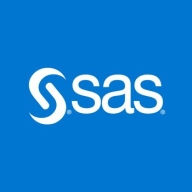

SAS Visual Analytics and Tableau compete in the data analysis and visualization category. Tableau seems to have the upper hand due to its ease of use, adaptability, and superior data visualization capabilities.
Features: SAS Visual Analytics offers a strong platform for metadata management, database control, and data integration. It excels in executing complex statistical analyses and developing sophisticated reports. Tableau provides quick visualization features, data exploration, and drag-and-drop analytics that enhance its self-service capabilities. It is particularly recognized for its predictive modeling and customization options.
Room for Improvement: SAS Visual Analytics users face challenges with complex installation and costly professional services. It needs better compatibility with modern data sources, robust data preparation tools, and enhanced forecasting. Tableau users suggest improving automation, visualization customization, and better integration with data modeling and machine learning tools. Users also find Tableau's cost and complexity with large datasets to be areas for improvement.
Ease of Deployment and Customer Service: SAS Visual Analytics primarily offers on-premises deployment and receives mixed reviews for customer service; support quality can vary by region. Tableau provides flexible deployment options across public and private clouds, as well as on-premises. Its customer service is generally effective, with quick responsiveness for installation issues, though support for complex troubleshooting could improve without additional charges.
Pricing and ROI: SAS Visual Analytics is considered expensive, particularly for smaller firms, with a complex pricing model often requiring additional plugin purchases. Despite this, its ROI is recognized through enhanced analytics and operational efficiency. Tableau is also costly, especially for smaller companies, but offers distinct licensing models. Its simplicity and effectiveness in delivering insights justify the price for many, though pricing adjustments could make it more competitive against alternatives like Power BI.
The enterprise subscription offers more benefits, ensuring valuable outcomes.
This saves a significant amount of time, particularly for reports that would have needed around fifty people.
They provide callbacks to ensure clarity and resolution of any queries.
The technical support for Tableau is quite good.
SAS Visual Analytics is stable and manages data effectively without crashing.
In terms of configuration, I would like to see AI capabilities since many applications are now integrating AI.
We cannot send the entire Excel file reports via email within Tableau.
The cost for viewer rights is around $60, but it can vary based on the business and is usually for a year.
The ability to query information from our Excel data into SAS to view specific data is invaluable.
The platform supports live connections and real-time data processing, which is crucial for our reconciliations that need frequent updates.


SAS Visual Analytics is a data visualization tool that is used for reporting, data exploration, and analytics. The solution enables users - even those without advanced analytical skills - to understand and examine patterns, trends, and relationships in data. SAS Visual Analytics makes it easy to create and share reports and dashboards that monitor business performance. By using the solution, users can handle, understand, and analyze their data in both past and present fields, as well as influence vital factors for future changes. SAS Visual Analytics is most suitable for larger companies with complex needs.
SAS Visual Analytics Features
SAS Visual Analytics has many valuable key features. Some of the most useful ones include:
SAS Visual Analytics Benefits
There are many benefits to implementing SAS Visual Analytics. Some of the biggest advantages the solution offers include:
Reviews from Real Users
Below are some reviews and helpful feedback written by PeerSpot users currently using the SAS Visual Analytics solution.
A Senior Manager at a consultancy says, “The solution is very stable. The scalability is good. The usability is quite good. It's quite easy to learn and to progress with SAS from an end-user perspective.
PeerSpot user Robert H., Co-owner at Hecht und Heck GmbH, comments, “What I really love about the software is that I have never struggled in implementing it for complex business requirements. It is good for highly sophisticated and specialized statistics in the areas that some people tend to call artificial intelligence. It is used for everything that involves visual presentation and analysis of highly sophisticated statistics for forecasting and other purposes.
Andrea D., Chief Technical Officer at Value Partners, explains, “The best feature is that SAS is not a single BI tool. Rather, it is part of an ecosystem of tools, such as tools that help a user to develop artificial intelligence, algorithms, and so on. SAS is an ecosystem. It's an ecosystem of products. We've found the product to be stable and reliable. The scalability is good.”
Tableau is a tool for data visualization and business intelligence that allows businesses to report insights through easy-to-use, customizable visualizations and dashboards. Tableau makes it exceedingly simple for its customers to organize, manage, visualize, and comprehend data. It enables users to dig deep into the data so that they can see patterns and gain meaningful insights.
Make data-driven decisions with confidence thanks to Tableau’s assistance in providing faster answers to queries, solving harder problems more easily, and offering new insights more frequently. Tableau integrates directly to hundreds of data sources, both in the cloud and on premises, making it simpler to begin research. People of various skill levels can quickly find actionable information using Tableau’s natural language queries, interactive dashboards, and drag-and-drop capabilities. By quickly creating strong calculations, adding trend lines to examine statistical summaries, or clustering data to identify relationships, users can ask more in-depth inquiries.
Tableau has many valuable key features:
Tableau stands out among its competitors for a number of reasons. Some of these include its fast data access, easy creation of visualizations, and its stability. PeerSpot users take note of the advantages of these features in their reviews:
Romil S., Deputy General Manager of IT at Nayara Energy, notes, "Its visualizations are good, and its features make the development process a little less time-consuming. It has an in-memory extract feature that allows us to extract data and keep it on the server, and then our users can use it quickly.
Ariful M., Consulting Practice Partner of Data, Analytics & AI at FH, writes, “Tableau is very flexible and easy to learn. It has drag-and-drop function analytics, and its design is very good.”
We monitor all Data Visualization reviews to prevent fraudulent reviews and keep review quality high. We do not post reviews by company employees or direct competitors. We validate each review for authenticity via cross-reference with LinkedIn, and personal follow-up with the reviewer when necessary.